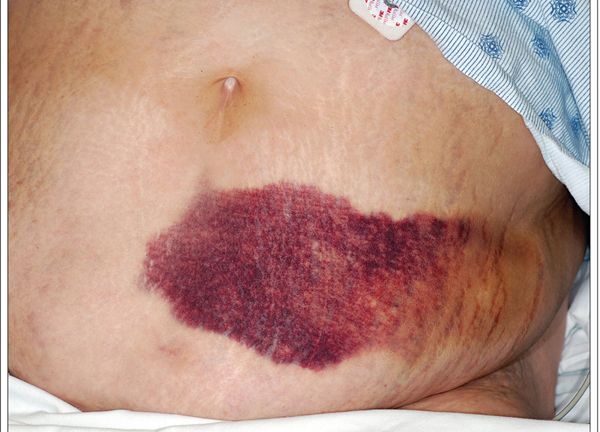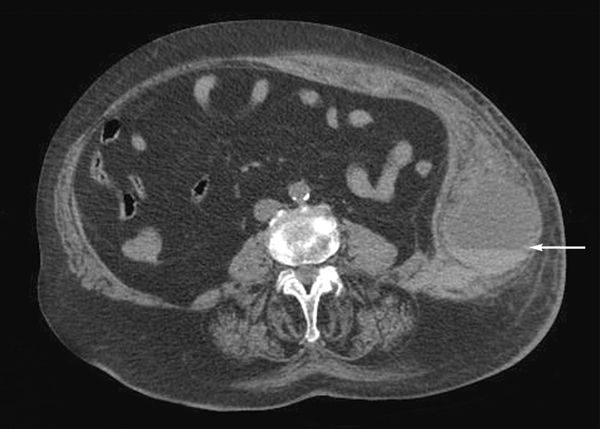- Clinical Technology
- Adult Immunization
- Hepatology
- Pediatric Immunization
- Screening
- Psychiatry
- Allergy
- Women's Health
- Cardiology
- Pediatrics
- Dermatology
- Endocrinology
- Pain Management
- Gastroenterology
- Infectious Disease
- Obesity Medicine
- Rheumatology
- Nephrology
- Neurology
- Pulmonology
Older Woman With Dyspnea and Large Abdominal Ecchymosis
THE CASE: A 77-year-old woman who has had shortness of breath and intermittent left flank pain for the past 2 to 3 days is brought by her family for evaluation. The dyspnea worsens when she lies down. She denies chest pain, back pain, and syncope. She has also had mild nonbloody diarrhea of 2 days’ duration but no vomiting or oral intake intolerance.

THE CASE: A 77-year-old woman who has had shortness of breath and intermittent left flank pain for the past 2 to 3 days is brought by her family for evaluation. The dyspnea worsens when she lies down. She denies chest pain, back pain, and syncope. She has also had mild nonbloody diarrhea of 2 days’ duration but no vomiting or oral intake intolerance.
She lives at home and has had no recent hospitalizations. Her medical history includes atrial fibrillation and a previous embolic cerebral stroke for which she takes warfarin. It has been at least a few months since her international normalized ratio (INR) was last checked.
The patient is in minimal discomfort and is afebrile. Heart rate is rapid, and rhythm is irregular. Systolic blood pressure is in the mid 90s. Chest shows no signs of trauma. Lung sounds are normal, with no crepitation or clinical evidence of rib fractures. There is a large (about 12 X 12-cm), firm, ecchymotic, exquisitely tender mass over the left side of the abdomen; no guarding, rebound, or peritoneal signs are present.
After further directed questioning, the patient reports that she had fallen in her bathroom a few days earlier.
What is the most likely cause of this patient’s symptoms?
• Idiopathic thrombocytopenic purpura
• Abdominal wall hematoma
• Thrombotic thrombocytopenic purpura
• Vasculitis
(Answer and discussion on next page.)
Answer: Abdominal wall hematoma
DISCUSSION: The patient was emergently transferred to the local hospital for further evaluation and management. In the emergency department, intravenous access was established and crystalloid fluid resuscitation was started. The patient’s blood pressure fell despite this therapy, and type O Rh-negative blood was given while her blood was typed and crossed. Because of high clinical suspicion of an abdominal wall hematoma, coupled with hemodynamic instability and concern about a possible coagulopathy, fresh frozen plasma and vitamin K were also given.
Laboratory values, including basic blood chemistry, urinalysis, and troponin, were normal. Complete blood cell count showed significant anemia, with a hemoglobin level of 7.7 g/dL and hematocrit of 24.3%. Prothrombin time and INR were not available until late into the patient’s clinical course. The laboratory values indicated severe coagulopathy, with the INR being initially incalculable.

A CT scan of the abdomen and pelvis without contrast showed a massive abdominal wall hematoma arising from the left rectus sheath of the lateral abdominal wall with a fluid-blood level (hematocrit sign) consistent with an acute hemorrhage (Figure). The bleeding did not intrude into the peritoneal cavity. Although surgery was initially considered, the surgical team recommended reversal of the coagulopathy first.
In the medical ICU, the patient’s vital signs had stabilized and correction of the coagulopathy was initiated. The INR returned to normal, and there were no further signs of shock; thus, invasive intervention was not required. The patient was discharged within a few days.
ABDOMINAL WALL HEMATOMA: A BRIEF OVERVIEW
There is a paucity of literature about abdominal wall hematomas, especially those that cause hemodynamic instability in patients who are receiving anticoagulation therapy.1-7 A hematoma can present with apparent bruising and/or tenderness over any aspect of the abdominal wall. Patients with hematomas typically do not have an underlying intra-abdominal pathology.
These patients can be distinguished from those with purpuric illnesses because they usually have a normal platelet count and normal coagulation parameters, unless they have been receiving anticoagulation therapy.
Depending on the amount of bleeding, the patient may have signs of hypoperfusion or shock. As in this case, when a patient who is taking a high-risk medication, such as warfarin, presents in hemorrhagic shock, emergent treatment involves resuscitation and correction of a presumed coagulopathy. If these measures fail, interventional embolization should be attempted. Other therapeutic options are fine-needle aspiration and surgery (ligation of the bleeding vessel).
DIFFERENTIAL DIAGNOSIS
Idiopathic thrombocytopenic purpura (ITP) is an autoimmune disease that results in rapid destruction of platelets. The diagnosis is typically based on a low platelet count, presence of petechiae or purpura, and no other obvious cause of thrombocytopenia. Patients with ITP rarely present with life-threatening bleeding complications, and they usually do not require treatment. However, those with severe thrombocytopenia may require corticosteroids. If there is no response to medical therapy, the final option is typically splenectomy. This patient’s platelet count was 409,000/μL, which ruled out ITP. Thrombotic thrombocytopenic purpura (TTP) is a rare but serious entity that typically presents with the classic pentad of thrombocytopenia, microangiopathic hemolytic anemia, fever, renal impairment, and neurological impairment.
This is usually caused by a failure of breakdown of von Willebrand factor, which causes large platelet thrombi to form and may result in severe end-organ damage. Pregnancy is the most common precipitating event; however, TTP can also be caused by autoimmune disorders (ie, lupus) and drugs (eg, cyclosporine). Affected patients can appear quite ill and require intensive supportive therapy with aggressive plasma exchange.
Vasculitis refers to a large group of disorders that cause petechiae and purpura. These include Henoch-Schönlein purpura, allergic vasculitis, and some infectious diseases (such as Rocky Mountain spotted fever). Treatment is directed toward the underlying cause.
This patient’s recent fall probably triggered massive bleeding in her abdominal wall because of her hypocoagulability resulting from warfarin therapy. An underlying infectious, allergic, or immunological process was an unlikely cause of her hematoma.
References:
REFERENCES:1. Tintinalli JE, Kelen GD, Stapcynski JS, eds. Emergency Medicine: A Comprehensive Study Guide. New York: McGraw-Hill; 2004:1324-1325, 1346, 1518.
2. Kao CL, Chang JP. Abdominal wall hematoma as complication of warfarinization. J Emerg Med. 2001;20:293.
3. Davies RS, Goh GJ, Curtis JM, et al. Abdominal wall haematoma in anticoagulated patients: the role of imaging in diagnosis. Australas Radiol. 1996;40: 109-112.
4. Ergün N, Cevik AA, Holliman J, et al. Conservative treatment of giant abdominal wall hematoma. Ulus Travma Acil Cerrahi Derg. 2004;10:141-144.
5. Ilkgül O, Ozden S, Ozsoy Y, et al. Late diagnosis of a lateral abdominal wall hematoma presenting with nonspecific findings: report of a case. Ulus Travma Acil Cerrahi Derg. 2007;13:316-318.
6. Tai CM, Liu KL, Chen CC, et al. Lateral abdominal wall hematoma due to tear of internal abdominal oblique muscle in a patient under warfarin therapy. Am J Emerg Med. 2005;23:911-912.
7. Lindbeck GH. Abdominal wall hematoma in an elderly man. Acad Emerg Med. 1995;2:134-138.
